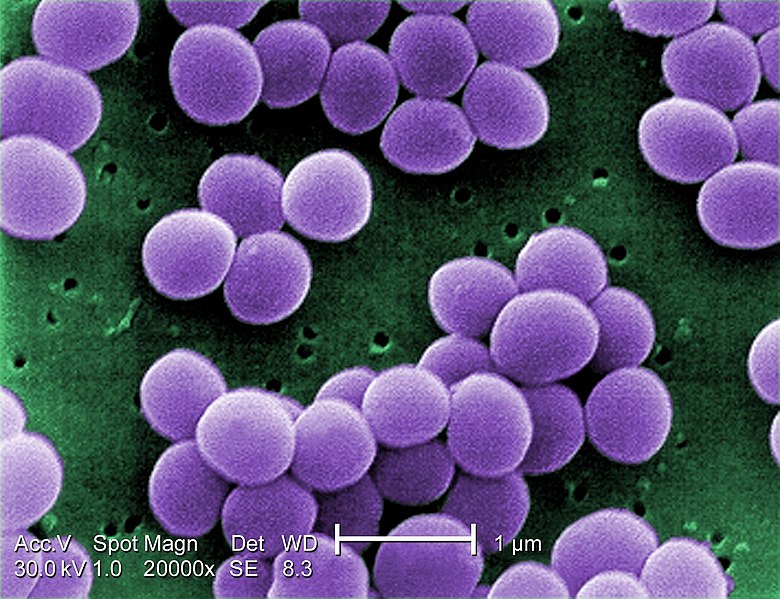File:Staphylococcus aureus VISA 2.jpg

Original file (1,420 × 1,091 pixels, file size: 259 KB, MIME type: image/jpeg)
Captions
Captions
| DescriptionStaphylococcus aureus VISA 2.jpg |
English: Under a very high magnification of 20,000x, this scanning electron micrograph (SEM) shows a strain of Staphylococcus aureus bacteria taken from a vancomycin intermediate resistant culture (VISA). Under SEM, one can not tell the difference between bacteria that are susceptible, or multidrug resistant, but with transmission electron microscopy (TEM), VISA isolates exhibit a thickening in the cell wall that may attribute to their reduced susceptibility to vancomycin . See PHIL 11156 for a black and white version of this image. VISA and VRSA are specific types of antimicrobial-resistant staph bacteria. While most staph bacteria are susceptible to the antimicrobial agent vancomycin some have developed resistance. VISA and VRSA cannot be successfully treated with vancomycin because these organisms are no longer susceptibile to vancomycin. However, to date, all VISA and VRSA isolates have been susceptible to other Food and Drug Administration (FDA) approved drugs. How do VISA and VRSA get their names? Staph bacteria are classified as VISA or VRSA based on laboratory tests. Laboratories perform tests to determine if staph bacteria are resistant to antimicrobial agents that might be used for treatment of infections. For vancomycin and other antimicrobial agents, laboratories determine how much of the agent it requires to inhibit the growth of the organism in a test tube. The result of the test is usually expressed as a minimum inhibitory concentration (MIC) or the minimum amount of antimicrobial agent that inhibits bacterial growth in the test tube. Therefore, staph bacteria are classified as VISA if the MIC for vancomycin is 4-8µg/ml, and classified as VRSA if the vancomycin MIC is >16µg/ml. |
||
| Date | |||
| Source |
|
||
| Author |
Content Providers(s): CDC/ Matthew J. Arduino, DRPH |
||
| Permission (Reusing this file) |
PD-USGov-HHS-CDC English: None - This image is in the public domain and thus free of any copyright restrictions. As a matter of courtesy we request that the content provider be credited and notified in any public or private usage of this image. |
| Public domainPublic domainfalsefalse |
This image is a work of the Centers for Disease Control and Prevention, part of the United States Department of Health and Human Services, taken or made as part of an employee's official duties. As a work of the U.S. federal government, the image is in the public domain.
eesti ∙ Deutsch ∙ čeština ∙ español ∙ português ∙ English ∙ français ∙ Nederlands ∙ polski ∙ slovenščina ∙ suomi ∙ македонски ∙ українська ∙ 日本語 ∙ 中文 ∙ 中文(台灣) ∙ 中文(简体) ∙ 中文(繁體) ∙ العربية ∙ +/− |
File history
Click on a date/time to view the file as it appeared at that time.
| Date/Time | Thumbnail | Dimensions | User | Comment | |
|---|---|---|---|---|---|
| current | 02:24, 4 August 2009 |  | 1,420 × 1,091 (259 KB) | Raeky (talk | contribs) | {{Information |Description={{en|1='''Under a very high magnification of 20,000x, this scanning electron micrograph (SEM) shows a strain of Staphylococcus aureus bacteria taken from a vancomycin intermediate resistant culture (VISA).'''<p> Under SEM, one |
You cannot overwrite this file.
File usage on Commons
The following 2 pages use this file:
File usage on other wikis
The following other wikis use this file:
- Usage on ar.wikipedia.org
- فيلقية
- أشعار بكتيرية
- آزوتية
- ريكتسيا
- مستجذرة
- مفطورة
- ملوية (جنس)
- وتدية خناقية
- متفطرة
- مطثية حاطمة
- هدب (بكتيريا)
- شعاوات
- متفطرة جذامية
- مرق السيلينيت
- بوريليا برغدورفيرية
- مكورات
- صبغة أورامين رومدامين
- اختبار الأكسيداز
- انزلاق بكتيري
- ملتويات (بكتيريا)
- ملتوية معوية
- نستق
- قالب:بذرة بكتيريا
- نوستك
- مستدمية
- كليبسيلا
- سفينغوبيوم
- جرثومة مخاطية
- متقلبات
- متقلبات زيتا
- متقلبات إيبسيلونية
- متقلبات غاما
- متقلبات بيتا
- متقلبات ألفا
- بكتيريا مغزلية
- عصوانيات
- خضربيات
- دليل برجاي لعلم الجراثيم المنهجي
- جراثيم ثؤلولية
- مستعلقات
- سحناوات
- متمصرة
- بكتيريا حمضية
- متدثرات
- كلورو بكتيريا
- شبكيات الكبب
- شبكية الكبة حرارية
- ليفيات
- سلسلية
- سلسلية طوقية الشكل
View more global usage of this file.
Metadata
This file contains additional information such as Exif metadata which may have been added by the digital camera, scanner, or software program used to create or digitize it. If the file has been modified from its original state, some details such as the timestamp may not fully reflect those of the original file. The timestamp is only as accurate as the clock in the camera, and it may be completely wrong.
| _error | 0 |
|---|
